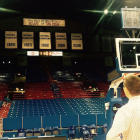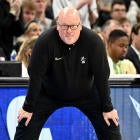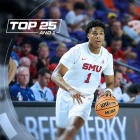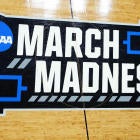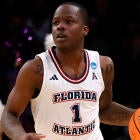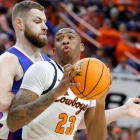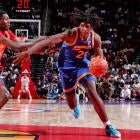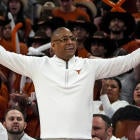
LAWRENCE, Kan. -- The lights go out and the videoboard plays. It's a mood-setter, a short film on the history of Kansas basketball, which is to say it's a short film on the history of the sport. Kansas is linked to the foundation of the game more than any other school and any other place outside of Springfield, Mass., where basketball's inventor, James Naismith, pioneered it by way of an assignment in 1891.
He's the founder of Kansas' basketball program, its first coach from 1898 until 1907. That's a fact too often overlooked or underplayed by those not connected to the program. The man who created basketball started his career at Kansas.
On Saturday night, during halftime of Kansas' highly anticipated home game against program compeer Kentucky, Naismith's original 13 rules for "Basket Ball" were rolled out, red carpet and all, to the middle of the James Naismith Court. Just before that though, the video. It included footage from the 2012 30 for 30 documentary, "There's No Place Like Home." The doc tells the story of how the University of Kansas came to be in possession of Naismith's rules, which amount to a delicate and cherished two-page constitution of sport. Over the course of 90 gripping seconds of edited footage, David Booth's record-setting $3.8 million bid played out in front of a captivated audience of more than 16,300 inside Allen Fieldhouse.
Auctioneer: "Two point three (million) on the phone. Would you say 2.4?"
Booth: "Yes."
Auctioneer: "Two point five. Would you say 2.6?"
Booth: "Yes."
The drama builds, more than 16,000 inside the Phog craning their necks at the four-sided videoboard.
Auctioneer: "They went to 3.1. Would you say 3.2?"
Booth: "Yes."
Cheers inside Allen Fieldhouse grow. Goosebumps everywhere. Everybody already knows the outcome, but it's engrossing to watch the auction crest to culmination.
Auctioneer: "Three point three. Would you say 3.4, sir?"
Booth, without hesitation: "Yes."
The documentary's catalyst and co-director, Kansas alum Josh Swade, can be seen behind Booth, pacing while smearing his face. Swade is in complete agony. It's terrific. After Booth's final competitor -- a Duke alum, he'd later find out -- bids $3.7 million, he deliberates and says, "OK, 3.8." Finally, there is no counter-bid, and with that, the rules are heading to Lawrence forever. With the commission from Sotheby's, and including taxes, Booth pays more than $4.3 million to purchase two pieces of paper that are nearly 120 years old. When he does this, it's the most money paid at an auction for any piece of sports memorabilia -- ever.
Then, he donates the artifacts to his alma mater.
On Saturday night, as Booth and his children removed the black sheet at centercourt to reveal the rules under glass, a man stood directly behind them. It was a Naismith, James Pomeroy Naismith, the last surviving grandchild of James and a man now in his 80th year of life. His age and resemblance brought to light just how special the occasion and connection. There have been many incredible moments at Allen Fieldhouse. Saturday night's ceremony could be the proudest in its history.
It's nothing special from the outside. That's what struck me first. Driving my way through Kansas' campus on Friday, I was surprised by how ordinary Allen Fieldhouse's exterior looked. When you approach 1651 Naismith Drive via the campus' main vein, the building -- which required approximately 650,000 bricks by the time it was finished in 1955 -- is obstructed by a parking garage.
From the east side of the premises, a statue of Phog Allen simply stands in front of the primary entrance to the building, which includes the elegant Booth Family Hall of Athletics. The jewel of this mini museum is the original "Pay Heed, All Who Enter: Beware of 'THE PHOG'" banner, which was stitched together in 1988. (Rumor has it this was something of a drunken endeavor, too.) This festive and homespun drape embodies what makes Allen Fieldhouse great: an unplanned addition that was embraced by the fans and kept hanging in an semi-impromptu way for 11 years, before the thing started to really deteriorate. (My favorite fact: the slogan was sort of a ripoff from a forgotten '80s horror movie.) Kansas fans loved the spirit of the sign so much that they rebelled when KU officials tried to replace it with a generic replica in 1999. Soon thereafter, a true and reinforced duplicate was hung high in the north wall. Now it's a classic go-to shot for any TV crew for every KU home game.

Inside, of course it's different, and that's what I really liked about it. It doesn't feel like a palace and it doesn't feel like a relic. Allen Fieldhouse is cozily tucked right on the edge of campus, but unless you're a fan of the game you wouldn't even know what's there unless you actually got to step through the doors. When you do you're not stepping into a time machine, and I think that's an important distinction. Butler's Hinkle Fieldhouse, The Palestra in Philadelphia and Rose Hill Gymnasium (home to Fordham and the longest active D-I gym in the sport) have this power of instantly transporting you and holding ghosts in the room. Allen Fieldhouse feels effortlessly timeless in a modern way.
There's a contemporary, clean, simple feel to the surrounding hallways and foyers that bumper the arena. Students "camp" out by way of a sophisticated grouping system with sporadic roll calls throughout the week to ensure they keep their place in line (a lottery drawn earlier in the week determines which group gets first dibs, second, third, etc. to enter). Only one group rep needs to be in the main concourse when roll is randomly called, so instead of 4,000 students camping outside of Allen Fieldhouse, you've got 300 or so students posted up inside on their phones, tablets or laptops. It looks like they're all waiting on a delayed flight at the airport.
By the time pre-game arrives, there are thousands of students cramped between the entrances and the garage. Group leaders hold up laminated blue sheets with their number on it so they can assemble and enter together once the doors open. A line more than 100 yards long forms for students who can't get in via lottery. Many of them will be turned away because, for the 238th consecutive game, it's a sellout.
It's a frenzy, a defining scene of what it feels like to be a student at a college basketball powerhouse. These kids don't even know how much they'll miss it once it's gone.
Students dashing to their seats. This is entirely too entertaining. https://t.co/mRxEAIEHCr
â Matt Norlander (@MattNorlander) January 30, 2016
***
The arena is basically filled -- no exaggeration here; maybe 5 percent of the seats weren't occupied -- with 30 minutes still to go before tip-off. This is obviously uncommon for most other places, which struggle to get everyone in the bowl in time for the national anthem. The student section soon after begins to yell "Rock chalk!" to one side of the arena, and a response of "Jay! Hawk!" is reciprocated. This lays the foundation for the audience's crescendo that will rise over the next 18 minutes. A woman is holding a sign that says she came from Alaska to watch this game in person. There are a few other signs with interesting slogans, brought in by students, that I can't share on this site. Long live college creativity.
Anthem. pic.twitter.com/FS1PkyDSj0
â Matt Norlander (@MattNorlander) January 31, 2016
There isn't a home venue with more acclaim than the Phog. KU is 739-109 in the building, the first win coming on March 1, 1955, against who else but Kansas State. They named the place after Forrest "Phog" Allen on that day. Kansas reports 17,228 people having witnessed the game. The attendance record has not been surpassed since. It might be the only venue in college basketball that saw its first game host its largest audience ever.
KU has lost only three home games since Feb. 4, 2007. No major American sports team can come close to matching that win percentage (a truly unfathomable .981 clip with a 154-3 record in that span). In the past decade Kansas basketball has -- by far -- the biggest home-venue advantage compared to every other team throughout all major American sports.
Now, having witnessed it and -- more emphatically, heard it -- I can understand why. Fully. This is the pregame hype video and environment from Saturday. It does not do the atmosphere of Allen Fieldhouse justice. Not by one-fiftieth of a margin.
The game, the surroundings, the electricity of Saturday night was so invigorating it even prompted a famous, modern cult icon -- nomadic fan figure Marlins Man -- to post via his Facebook page a declarative statement: "I need to tell everyone that last Saturday night was probably the best basketball experience that i have ever been to."
After the hype video, shortly before tip, as the sky turned crepuscular and my ears attempted to ajdust back to normal functioning levels, the crowd breaks into the famous and haunting six-syllable horror hymnal.
Rock / Chalk / Jay / Hawk / K / U.
The chant unintentionally starts a few notes too high before dropping down to its normal key. Goosebumps. The sensation is really tough to describe. You go from this out of control electro-volcano, audio-technical pyro production to a recitative canticle that sounds like it's been around for millenia. From there, it's impossible not to be caught in the crowd's cowcatcher. It was all there early, the myriad fouls against Kentucky -- it was in the bonus by the 14-minute mark -- and the utter contempt and disgust from the Phog Allen Faithful for pretty much any call that went against the 'Hawks. Hilarious and true to their reputation.
The game -- which was remarkably fun and entirely unpredictable -- gets to overtime after Frank Mason almost buries a 48-footer at the end of regulation. If Mason makes that shot, I'm probably unconscious five seconds later.
Before the bonus session starts, the decibel level hits 118. Someone is saying something to me, but I can't even pretend to hear a damn thing because it's so loud. It's right there in that moment that I know I'm experiencing something so special to the job and vital to the sport. I can't believe it -- and I sort of told myself I wouldn't let it happen -- but the ethos of the building has lived up to the enormous amounts of hype that comes with it. I want everyone who loves college basketball -- OK, basketball -- to venture to Lawrence and get to live through something like this.
Kansas gets the win, of course it does, this being the 201st victory for Bill Self in 210 games there. Fans are roped off but lined up to shake hands and earn autographs just outside the vomitorium. They stay there a good 30 minutes after the game ends. After Self's press conference, he comes up and says, "How about it? Nothing like it, is there? It's awesome -- just totally awesome."
Indeed. The Phog is a spectacle and experience to itself, unmatched in college basketball but also in all of sports. The best part is it's made possible not by any tricky architecture of the building or any acoustic quirks that enhance the environment. Allen Fieldhouse is so distinctive and intimidating because of the beloved vehemence and unrelenting passion of the fan base. The indelible house can live forever because Kansas fans will always bring it to life. I can still hear the noise, and I assume I'll hear it for the rest of my life.














